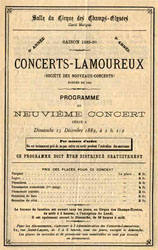
![]()
Conductors: Charles Lamoureux
The Concerts Lamoureux and Berlioz, 1881-1914
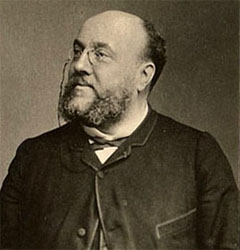
 |
Conductors: Charles LamoureuxThe Concerts Lamoureux and Berlioz, 1881-1914 |
 |
Introduction
Charles
Lamoureux
Camille
Chevillard
Table of concerts
Charles
Lamoureux
Camille
Chevillard
Illustrations
This page is also available in French
Copyright notice: The texts, photos, images and musical scores on all pages of this site are covered by UK Law and International Law. All rights of publication or reproduction of this material in any form, including Web page use, are reserved. Their use without our explicit permission is illegal.
![]()
Charles Lamoureux (1834-1899), the founder of the concert society which still bears his name, is chiefly remembered for his dedicated and successful promotion of the music of Wagner in Paris in the 1880s and 1890s. His inclusion side by side with other conductors of his time who can be considered genuine champions of Berlioz, notably Jules Pasdeloup, Hans von Bülow, and above all Édouard Colonne, is nevertheless justified for several reasons. He did in fact conduct regularly a certain amount of music by Berlioz, from the beginnings of his concert society in 1881 down to his death in 1899. His inclusion of Berlioz from the start reflects the great popularity of the composer in France at the time (see the page on the Berlioz revival after 1869). His successor Camille Chevillard followed his example down to the season 1913-1914, at which point the outbreak of the First World War in the summer of 1914 put an abrupt end to most artistic activity in France for five years. The table below gives a chronological summary of performances of Berlioz in Paris at the Concerts Lamoureux from 1881 to 1914, together with references to the weekly journal Le Ménestrel, the source from which this information has been compiled, and a selection of reviews of these concerts taken from the same journal. These are reproduced in the original in the French version of this page, for which links are provided.
It will be seen that Lamoureux’s Berlioz repertoire was evidently much more restricted than that of Édouard Colonne, the founder of the rival but complementary concert society, who was thought of, in France and abroad, as the leading Berlioz champion of his time. The only major works of Berlioz which Lamoureux performed complete with some frequency were la Damnation de Faust, by far the most popular work of Berlioz at the time (some 12 performances in all in Paris, in 1884, 1885 and 1896), and the Symphonie fantastique (8 performances, in 1887, 1888, 1890 and 1894). Lamoureux was clearly prepared on occasion to challenge Colonne on his own ground. Otherwise his Berlioz repertoire consisted of shorter pieces: a limited number of overtures (especially the Carnaval romain), and popular orchestral or vocal excerpts from some of the major works. For example, he played from time to time excerpts from Harold en Italie, Roméo et Juliette, and l’Enfance du Christ, but never the complete works, and was sometimes criticised for this (see a review of 22 December 1895). One special favourite of his was the Marche hongroise which he frequently played as a suitably rousing piece to end a concert. But he did have one significant achievement to his credit: it was Lamoureux, and not Colonne, who conducted the first staged performance of Berlioz’s opera Béatrice et Bénédict in Paris in June 1890, some 28 years after its first performance in Baden-Baden in 1862.
Lamoureux and Colonne were initially colleagues, both of them students of the Conservatoire, and at one time played first and second violins respectively in a string quartet (for an outline of their careers see the obituaries of Lamoureux and Colonne, and an evaluation of their respective achievement by the writer Romain Rolland in 1908). They also shared a common debt to Jules Pasdeloup, the founder of the Concerts populaires, whose example inspired them, as Colonne was happy to acknowledge later. Though younger than Lamoureux, Colonne founded his concert society earlier, in 1873, while Lamoureux only founded his in 1881 (it was initially called the Sociéte des Nouveaux-Concerts and soon became known as the Concerts Lamoureux). With the demise of the Concerts populaires of Jules Pasdeloup in 1884 the two societies dominated Parisian concert life throughout the 1880s, 1890s and beyond and survived the death of their founders (the older Société des Concerts du Conservatoire retained its prestige and high standards but was less adventurous in its programming, and also played to smaller audiences because of the limited capacity of the Conservatoire). Both societies gave their concerts on Sunday afternoons between October and April, and were thus in competition for an audience. It was inevitable that comparisons should constantly have been drawn between the two conductors, their personality, style of performance and repertoire, and the different character of their audiences. When discussing Lamoureux it is therefore unavoidable that Colonne should also be mentioned, and vice versa.
In founding his own concert society Lamoureux’s ambition was to establish and maintain high standards of performance, and he recruited for his orchestra the best players available. The Lamoureux orchestra was larger than the standard symphony orchestra of the late 20th century. An announcement of 1886 gives detailed figures for the start of the new season: with 78 strings, 20 wind and 18 brass, the orchestra numbered some 125 players in all (Colonne’s orchestra was slightly smaller, but still numbered over 100 players). Reviews of the early concerts suggest that the Lamoureux orchestra was indeed of a high standard and could rival the Conservatoire. In conscious reaction to the Pasdeloup concerts, which were probably too ‘popular’ and rowdy for his taste, Lamoureux also tried to introduce a more disciplined and respectful atmosphere into the concert hall, and laid down strict rules on admittance (see the review of 5 November 1882). He tried to ban the practice of encores, which remained a regular feature of Colonne’s concerts, though without complete success (see the reviews of 10 February 1884 and 3 February 1895): concert audiences in Paris at that time regarded it as their right to demand an encore on the spot if a piece or performer had particularly pleased them; conversely, they were quick to show their displeasure if anything seemed to them unsatisfactory. Reviewers not infrequently commented on the different atmosphere of the Lamoureux and the Colonne concerts, the former more restrained and even strait-laced, the latter freer and more spontaneous (see the reviews of 27 December 1885, 28 February and 19 December 1886, 30 October 1909, and the comments of Romain Rolland). At times Pasdeloup and Colonne even had to address their audiences to calm tempers when matters threatened to get out of hand, but this seems not to have been a frequent occurrence at Lamoureux’s concerts. As a conductor Lamoureux is characterised as having been strict, precise, and economical in his gestures, whereas Colonne was freer and conveyed greater warmth and spontaneity (see the reviews of 4 March 1888 and 28 April 1889). As an interpreter of Berlioz Lamoureux was capable of giving performances that critics thought outstanding, such as his first performances of la Damnation de Faust in 1884 (see the review of 10 February) and of the Symphonie fantastique in 1887 (see the review of 23 January). But he was also accused at times of being too clinical and rigid, and individual performances were criticised (see the reviews of 23 November 1884, 6 November and 13 November 1887, 2 March and 14 December 1890). He was even accused of being altogether out of sympathy with Berlioz’s music and advised at times to avoid it altogether… (see the reviews of 14 January and 21 January 1894). But it might be suggested that in his greater precision in detail and adherence to stricter tempi than was the case with Colonne, Lamoureux was perhaps closer to the letter, if not the spirit, of Berlioz’s music. It should also be added that criticism of Lamoureux was partly motivated by opposition to Wagner and his music, which Lamoureux championed consistently in his concerts. This is particularly the case in the reviews signed by Hippolyte Barbedette, an avowed critic of Wagner (see the reviews of 23 March and 30 March 1890, 17 April 1892, 16 December 1894, and 20 December 1896); another veteran critic, Arthur Pougin, even broke his friendship with Lamoureux over the question of Wagner, as he reveals in the obituary he wrote of Lamoureux. But it was to the great credit of Lamoureux, and indeed to that of his fellow conductors Pasdeloup and Colonne, that there were able to rise above nationalistic considerations and carry a significant part of the public with them.
By 1897 Lamoureux felt that he had reached the end of the road with his enterprise in Paris and would instead pursue his career abroad. His orchestra reconstituted itself as a new society but preserved the name of its founder, and appointed Lamoureux’s son in law Camille Chevillard to succeed him (see the entries of 17 October and 21 November 1897). Lamoureux did in fact return to lead his orchestra the following year, and had the satisfaction of conducting the first staged performance of Tristan und Isolde in Paris not long before his death on 21 December 1899. His critics posthumously acknowledged his achievement (see the obituary of 24 December 1899, and the review of 7 January 1900).
Chevillard had been appointed conductor of the Lamoureux orchestra already in 1897 (see the table of concerts for 1897, 1898 and 1899), and he naturally continued at the head of the society after Lamoureux’s death, just as at the Châtelet Gabriel Pierné was the natural successor to Édouard Colonne (for an assessment of Chevillard’s qualities and achievement see the comments of Romain Rolland). As far as the programming of music by Berlioz was concerned, there was no sudden change of policy at the Concerts Lamoureux. Berlioz continued to be part of the regular repertoire of the society without being a speciality as he was at the Châtelet, though overall Chevillard performed slightly less Berlioz than Lamoureux had done. The figures in this section refer to performances conducted by Chevillard himself from 1900 onwards, and do not include those under guest conductors (such as Felix Weingartner, a frequent visitor: he conducted performances of Berlioz with the orchestra in 1898, 1899, 1901, 1902 and 1906; it was Lamoureux who had invited Weingartner to come to Paris).
In general there was a similarity of approach between the two conductors with the music of Berlioz, though some differences in detail: the tendency was to perform shorter pieces, or excerpts of the larger works rather than complete performances. Like Lamoureux, Chevillard performed la Damnation de Faust complete with some frequency (8 performances, in 1903 for the Berlioz centenary, then again in 1905, 1906 and 1907), as well as playing excerpts from the work quite often (though he was less addicted to the Marche hongroise than Lamoureux had been). Both conductors often performed individual movements from Roméo et Juliette, but never the complete work. Similarly neither gave a complete performance of l’Enfance du Christ, and Chevillard showed less interest than Lamoureux in Part II of the work. Two of the overtures were particularly popular with Chevillard, Benvenuto Cellini and Carnaval romain, particularly the former (13 performances against 11), whereas Lamoureux had a very strong preference for the latter work. Other overtures received only isolated performances from Chevillard (Béatrice et Bénédict, les Francs-Juges), as had been the case with Lamoureux. On the Symphonie fantastique the two conductors diverged: Lamoureux favoured the work, but Chevillard never gave a single performance. Nor did he follow Lamoureux’s practice of performing the second movement from Harold en Italie on its own, but he did give a complete performance of the work, though late in the day (1912). Neither did he share Lamoureux’s interest in any of the individual pieces of Tristia, or in the duet from Béatrice et Bénédict, but he did give a number of performances of separate arias from les Troyens, and shared Lamoureux’s liking for the Chasse royale et orage as a separate concert piece (though one critic found it too short for the purpose). Individual songs from les Nuits d’été received rare performances, and Chevillard’s last Berlioz performance in 1914 was of la Captive. Overall the record at Lamoureux cannot be compared with that of the Concerts Colonne. It is interesting to note that the Conservatoire for its part did give complete performances of both Roméo et Juliette and l’Enfance du Christ.
Chevillard’s Berlioz conducting evoked the same mixed responses from critics as his predecessor had done. Individual performances could receive high praise from different critics (see for example the reviews of 23/11/1902 [Chasse royale], 14/12/1902 and 13/12/1903 [excerpts from Roméo], or 20/12/1903, 27/12/1903 and 26/3/1905 [complete Damnation]). But the practice of Chevillard, as that of Lamoureux before him and of the Conservatoire, of excerpting larger works instead of playing them complete, came in for frequent criticism (see the reviews of 14/12/1902, 3/1/1904, 11/12/1904, 19/11/1905, and 11/3/1911). Individual performances were sometimes criticised as mismanaged (25/10/1903, overture to Benvenuto Cellini) or cold and unsympathetic (9/2/1907 and 16/2/1907, complete Damnation). One critic, Amédée Boutarel, even suggested that Chevillard, as Lamoureux before, would be well advised to avoid Berlioz altogether rather than betray his spirit… More than once he drew a pointed contrast between Berlioz and Wagner: among composers Berlioz was an aristocrat who needed a finer touch and greater sensitivity than the more heavy-handed Wagner, whose music was such a large component of the Lamoureux concerts (see his reviews of 7/4/1901, 19/11/1905, 16/2/1907, 6/11/1909, and 11/2/1911).
![]()
The following table gives a listing of all the performances of music by Berlioz given at various venues in Paris by the Concerts Lamoureux, from their foundation in 1881 to the outbreak of the First World War in 1914 (performances outside Paris are excluded for the most part, and would probably not affect the overall pattern). The table has been divided into two parts: the performances given by Charles Lamoureux from 1881 to his death in 1899, and those given by his successor Camille Chevillard from 1900 to 1914. Unless otherwise indicated all the concerts between 1881 and 1897 were conducted by Lamoureux, and all those between 1900 and 1914 by Chevillard (it will be seen that from the late 1890s guest conductors, especially German, became increasingly frequent). All the evidence has been taken from the concert-listings in the weekly journal Le Ménestrel. Links are given to reviews of performances, which will be found in the original in the French version of this page. Hippolyte Barbedette and Amédée Boutarel, the critics whose names recur most frequently in reviews from 1884 onwards, are briefly discussed on another page of this site.
In the column of works in the table below the following abbreviations have been used. Béatrice = Béatrice et Bénédict, Benvenuto = Benvenuto Cellini, Carnaval = overture le Carnaval romain, Chasse = Chasse royale et orage from Les Troyens, Damnation = la Damnation de Faust, Enfance = l’Enfance du Christ, Fantastique = Symphonie fantastique, Francs-Juges = overture les Francs-Juges, Harold = Harold en Italie, Invitation = Invitation to the Dance (Weber, orch. Berlioz), Invocation = Invocation à la nature from Damnation, Marche = Marche hongroise from Damnation, Repos = Le Repos de la Sainte Famille from l’Enfance du Christ, Roméo = Roméo et Juliette, Trio = Trio for 2 flutes and harp from Enfance, Valse = Valse des Sylphes from Damnation. Where a title is mentioned without qualification (e.g. Damnation) it refers to a performance of the complete work.
|
| Date | Work | Le Ménestrel | Reviews/Notes |
| 1881 | |||
| 23 October | Béatrice (duet), Carnaval | 23/10, p. 375; 30/10, p. 383 | Wilder (opening concert by Lamoureux) |
| 30 October | Béatrice (duet), Carnaval | 30/10, p. 384 | |
| 1882 | |||
| 12 February | Carnaval, Marche | 12/2, p. 87; 19/2, p. 94 | |
| 19 February | Carnaval, Marche | 19/2, p. 95 | |
| 22 October | Carnaval | 22/10, p. 375; 29/10, p. 383 | Wilder |
| 29 October | Carnaval | 29/10, p. 384; 5/11, p. 390 | Dubreuile |
| 19 November | Béatrice (duet) | 19/11, p. 407; 26/11, p. 415 | Dubreuile |
| 26 November | Béatrice (duet) | 26/11, p. 416; 3/12, p. 7 | |
| 1883 | |||
| 4 November | Carnaval | 4/11, p. 391; 11/11, p. 399 | Wilder |
| 11 November | Carnaval | 11/11, p. 400; 18/11, p. 407 | |
| 29 December | Damnation | 11/11, p. 400 | Performance in Lille |
| 30 December | Damnation | 11/11, p. 400 | Performance in Lille |
| 1884 | |||
| 3 February | Damnation | 3/2, p. 80; 10/2, p. 86 | Morsac |
| 10 February | Damnation | 10/2, p. 88; 17/2, p. 95 | Barbedette |
| 17 February | Damnation | 17/2, p. 96; 24/2, p. 103 | |
| 24 February | Damnation | 24/2, p. 103 & 104; 2/3, p. 111 | |
| 6 April | Damnation (2 excerpts) | 6/4, p. 152; 13/4, p. 159 | |
| 9 November | Harold (2nd & 3rd mov.) | 9/11, p. 399; 16/11, p. 407 | |
| 16 November | Harold (2nd & 3rd mov.) | 16/11, p. 407; 23/11, p. 415-16 | Barbedette |
| 7 December | Carnaval | 7/12, p. 8; 14/12, p. 14 | |
| 14 December | Carnaval | 14/12, p. 14; 21/12, p. 23 | |
| 21 December | Trio | 21/12, p. 23; 28/12, p. 31 | |
| 28 December | Damnation | 28/12, p. 32; 4/1/1885 p. 39 | |
| 1885 | |||
| 11 January | Damnation | 11/1, p. 47 | Reyer |
| 18 January | Damnation | 18/1, p. 56; 25/1, p. 63 | |
| 22 February | Damnation | 22/2, p. 95 | |
| 13 December | Troyens (aria), Béatrice (duet) | 13/12, p.15 | |
| 20 December | Carnaval | 20/12, p. 24; 27/12, p. 30 | |
| 1886 | |||
| 7 November | Francs-Juges, Harold (2nd mov.) | 31/10, p. 388; 7/11, p. 395; 14/11, p. 403 | |
| 5 December | Carnaval | 5/12, p. 7 | |
| 1887 | |||
| 9 January | Fantastique | 9/1, p. 47; 16/1, p. 55 | Barbedette |
| 16 January | Fantastique | 16/1, p. 55; 23/1, p. 62 | Boutarel |
| 30 January | Carnaval | 30/1, p. 72; 6/2, p. 79 | |
| 27 March | Damnation (excerpts) | 27/3, p. 135; 3/4, p. 143 | Boutarel |
| 30 October | Harold (2nd mov.) | 30/10, p. 351; 6/11, p. 358 | Boutarel |
| 6 November | Carnaval | 6/11, p. 359; 13/11, p. 367 | Moreno |
| 27 November | Trio | 27/11, p. 383; 4/12, p. 391 | Boutarel |
| 18 December | Invitation | 18/12, p. 407; 25/12, p. 414 | |
| 25 December | Invitation, Carnaval | 25/12, p. 415; 1/1/1888, p. 7 | Boutarel |
| 1888 | |||
| 8 January | Fantastique | 8/1, p. 15; 15/1, p. 24 | Barbedette |
| 15 January | Fantastique | 15/1, p. 24; 22/1, p. 31 | Boutarel |
| 19 February | Marche | 19/2, p. 64; 26/2, p. 71 | |
| 26 February | Marche | 26/2, p. 72; 4/3, p. 79 | |
| 18 November | Enfance (Repos) | 18/11, p. 376; 25/11, p. 383 | |
| 9 December | Carnaval | 9/12, p. 398; 16/12, p. 407 | |
| 1889 | |||
| 6 January | Harold (2nd mov.) | 6/1, p. 7; 13/1, p. 16 | Boutarel |
| 13 January | Harold (2nd mov.) | 13/1, p. 16; 20/1, p. 23 | Barbedette |
| 3 February | Damnation (Invocation) | 3/2, p. 39; 10/2, p. 47 | |
| 3 March | Marche | 3/3, p. 72; 10/3, p. 79 | |
| 10 March | Marche | 10/3, p. 79; 17/3, p. 87 | |
| 17 March | Carnaval | 17/3, p. 87; 24/3, p. 95 | Boutarel |
| 23 May | Béatrice (duet) | 5/5, p. 140; 26/5, p. 165-6 | Trocadéro, 1889 Exhibition |
| 20 October | Benvenuto (overture) | 20/10, p. 335; 27/10, p. 344 | |
| 27 October | Benvenuto (overture) | 27/10, p. 344 | |
| 24 November | La Captive | 24/11, p. 376; 1/12, p. 383 | |
| 1 December | La Captive | 1/12, p. 384; 8/12, p. 390 | Boutarel |
| 15 December | Béatrice (duet) | 15/12, p. 397; 22/12, p. 405 | See the programme below |
| 22 December | Troyens (aria) | 22/12, p. 406; 29/12, p. 413 | |
| 1890 | |||
| 12 January | Fantastique | 12/1, p. 16; 19/1, p. 21-22 | Boutarel |
| 19 January | Fantastique | 19/1, p. 22; 26/1, p. 30 | Barbedette |
| 26 January | Trio | 26/1, p. 30; 2/2, p. 37 | |
| 2 February | Trio | 2/2, p. 38; 9/2, p. 45 | |
| 16 February | Roméo (2nd, 3rd, 4th mov.), Carnaval | 16/2, p. 54; 23/2, p. 60 | Barbedette |
| 23 February | Roméo (2nd, 3rd, 4th mov.) | 23/2, p. 61; 2/3, p. 70 | Boutarel |
| 16 March | Marche | 16/3, p. 85; 23/3, p. 93 | Barbedette |
| 11 April | Enfance (excerpts, Part II) | 13/4, p. 119 | Good Friday |
| 3 June (Théâtre de l’Odéon) | Béatrice | 11/5, p.151; 8/6, p. 178-9 | Boutarel, Reyer |
| 9 November | Benvenuto (overture) | 9/11, p. 360; 16/11, p. 368 | |
| 16 November | Harold (2nd mov.) | 16/11, p. 368; 23/11, p. 374 | |
| 30 November | Roméo (2nd, 3rd, 4th mov.) | 30/11, p. 383; 7/12, p. 391 | |
| 7 December | Roméo (2nd, 3rd, 4th mov.) | 7/12, p. 391; 14/12, p. 399 | Boutarel |
| 14 December | Fantastique | 14/12, p. 399; 21/12, p. 405 | |
| 21 December | Marche | 21/12, p. 405; 28/12, p. 412 | |
| 1891 | |||
| 25 January | La Captive | 25/1, p. 30; 1/2, p. 37 | |
| 8 February | Carnaval | 15/2, p. 55 | |
| 15 March | Marche | 15/3, p. 86; 22/3, p. 94 | |
| 22 March | Marche | 22/3, p. 94; 29/3, p. 101 | |
| 29 March | Damnation (aria), Béatrice (duet) | 5/4, p. 109 | |
| 1892 | |||
| 17 January | Roméo (2nd, 3rd, 4th mov.) | 17/1, p. 21; 24/1, p. 31 | Boutarel |
| 24 January | Roméo (2nd, 3rd, 4th mov.) | 24/1, p. 31 | |
| 14 February | Marche | 14/2, p. 53; 21/2, p. 62 | |
| 6 March | Marche | 6/3, p. 78; 13/3, p. 85 | |
| 20 March | Marche | 20/3, p. 93; 27/3, p. 101 | |
| 23 October | Carnaval | 23/10, p. 342; 30/10, p. 351 | |
| 6 November | Enfance (Repos) | 6/11, p. 360; 13/11, p. 367 | |
| 13 November | Enfance (Repos) | 13/11, p. 367 | |
| 1893 | |||
| 26 March | Damnation (excerpts) | 26/3, p. 101 | |
| 1 April | Damnation (excerpts) | 2/4, p. 109 | |
| 12 November | Roméo (2nd mov.) | 12/11, p. 365; 19/11, p. 373 | |
| 19 November | Roméo (2nd mov.) | 19/11, p. 374; 26/11, p. 383 | Boutarel |
| 24 December | Chasse | 24/12, p. 413; 31/12, p. 419 | |
| 1894 | |||
| 7 January | Fantastique, Tristia no. 3, Chasse | 14/1, p. 13 | Boutarel |
| 14 January | Tristia no. 3 | 14/1, p. 14; 21/1, p. 21 | Barbedette |
| 21 January | Enfance (overture, Part II) | 21/1, p. 21; 28/1, p. 30 | |
| 28 January | Enfance (overture, Part II), Marche | 28/1, p. 30; 4/2, p. 37 | |
| 18 February | Tristia no. 2 | 18/2, p. 54; 25/2, p. 61 | Boutarel |
| 4 March | Valse, Marche | 4/3, p. 69; 11/3, p. 77 | Boutarel |
| 6 May | Wagner-Berlioz concert | 29/4, p. 136; 6/5, p. 143 | Trocadéro, popular concert |
| 13 May | Damnation (Invocation) | 13/5, p. 151 | Trocadéro |
| 18 November | Marche | 18/11, p. 365; 25/11, p. 374 | |
| 25 November | Marche | 25/11, p. 374; 2/12, p. 380 | |
| 2 December | Carnaval, Chasse | 2/12, p. 380; 9/12, p. 388 | |
| 9 December | Chasse | 9/12, p. 388; 16/12, p. 396 | Barbedette |
| 23 December | Enfance (Repos) | 23/12, p. 405; 30/12, p. 412-13 | |
| 1895 | |||
| 6 January | Chasse, Valse | 6/1, p. 4 | Popular concert |
| 27 January | Valse | 27/1, p. 29; 3/2, p. 36 | Boutarel |
| 17 March | Harold (2nd mov.) | 17/3, p. 85 | |
| 31 March | Roméo (2nd mov.) | 31/3, p. 101 | |
| 10 November | Fantastique (4th mov.) | 10/11, p. 357; 17/11, p. 366 | |
| 1 December | Harold (2nd mov.) | 1/12, p. 382; 8/12, p. 389 | Boutarel |
| 15 December | Harold (3rd mov.) | 15/12, p. 396; 22/12, p. 405 | Boutarel |
| 1896 | |||
| 26 January | Damnation | 26/1, p. 30; 2/2, p. 38 | Barbedette |
| 2 February | Damnation | 2/2, p. 38; 9/2, p. 45 | |
| 9 February | Damnation | 9/2, p. 45 | |
| 16 February | Damnation | 16/2, p. 53 | |
| 23 February | Invitation | 23/2, p. 62; 1/3, p. 69 | |
| 1 March | Invitation | 1/3, p. 69; 8/3, p. 77 | |
| 29 November | Roméo (4th mov.) | 29/11, p. 381; 6/12, p. 389 | |
| 13 December | Carnaval | 13/12, p. 397; 20/12, p. 404 | |
| 1897 | |||
| 17 January | Béatrice (duet) | 17/1, p. 21; 24/1, p. 30 | Barbedette |
| 24 January | Béatrice (duet) | 24/1, p. 30; 31/1, p. 37 | |
| 21 February | Marche | 21/2, p. 62; 28/2, p. 69 | |
| 14 March | Marche | 14/3, p. 86; 21/3, p. 93 | |
| 4 April | Marche | 4/4, p. 109 | |
| 5 December | Marche | 5/12, p. 389; 12/12, p. 396 | Concert conducted by Chevillard |
| 12 December | Marche | 12/12, p. 396; 19/12, p. 404 | Concert conducted by Chevillard |
| 1898 | |||
| 27 February | Fantastique | 27/2, p. 68; 6/3, p. 77 | Concert conducted by Felix Weingartner |
| 27 March | Roméo (3rd mov.) | 27/3, p. 101; 3/4, p. 109 | Concert conducted by Felix Mottl |
| 15 April | Damnation (Invocation) | 17/4, p. 124 | Good Friday concert, conducted by Chevillard |
| 27 November | Troyens (excerpts) | 27/11, p. 380; 4/12, p. 389 | Barbedette (concert conducted by Chevillard) |
| 4 December | Berlioz concert | 4/12, p. 389; 11/12, p. 397 | Boutarel (concert conducted by Chevillard) |
| 11 December | Roméo (2nd mov.), Damnation (excerpts) | 11/12, p. 397; 18/12, p. 404 | Concert conducted by Chevillard |
| 1899 | |||
| 5 February | Roméo (2nd & 3rd mov.) | 5/2, p. 46; 12/2, p. 53 | Concert conducted by Felix Weingartner |
| 26 March | Absence | 26/3, p. 101 | Concert conducted by Chevillard (?) |
| 12 November | Carnaval | 12/11, p. 368; 19/11, p. 373 | Boutarel (concert conducted by Lamoureux) |
| 19 November | Carnaval | 19/11, p. 374; 26/11, p. 381 | Concert conducted by Lamoureux |
![]()
| Date | Work | Le Ménestrel | Reviews/Notes |
| 1900 | |||
| 21 January | Troyens (aria) | 28/1, p. 29 | Boutarel |
| 28 January | Marche | 28/1, p. 29; 4/2, p. 37 | |
| 11 February | Benvenuto (overture) | 11/2, p. 46; 18/2, p. 52 | Barbedette; see the programme below |
| 18 February | Benvenuto (overture) | 18/2, p. 52; 25/2, p. 61 | |
| 4 March | Le Roi Lear | 4/3, p. 68; 11/3, p. 77 | Boutarel; conducted by Richard Strauss |
| 8 April | Carnaval | 8/4, p. 110 | Conducted by Felix Weingartner |
| 25 November | Troyens (aria), Roméo (2nd mov.), Absence, Carnaval | 25/11, p. 373; 2/12, p. 381-2 | Barbedette |
| 16 December | Benvenuto (overture) | 16/12, p. 397; 23/12, p. 405 | |
| 1901 | |||
| 24 February | Benvenuto (overture), Rob Roy | 24/2, p. 61; 3/3, p. 68 | Conducted by Felix Weingartner |
| 3 March | Troyens (aria) | 3/3, p. 68; 10/3, p. 78 | |
| 10 March | Marche | 10/3, p. 78 | |
| 17 March | Marche | 17/3, p. 85 | |
| 20 October | Benvenuto (overture) | 20/10, p. 336; 27/10, p. 341 | |
| 3 November | Marche | 3/11, p. 349; 10/11, p. 357 | |
| 22 December | Marche | 22/12, p. 404; 29/12, p. 412 | |
| 29 December | Enfance (2nd part) | 29/12, p. 412; 5/1/1902, p. 6 | |
| 1902 | |||
| 19 January | Carnaval | 19/1, p. 21 | |
| 9 February | Carnaval | 9/2, p. 46; 16/2, p. 52 | |
| 2 March | Harold, Fantastique | 2/3, p. 71; 9/3, p. 77 | Conducted by Felix Weingartner |
| 13 April | Benvenuto (overture) | 13/4, p. 117; 20/4, p. 125 | |
| 27 May | Carnaval | 25/5, p. 168 | Special concert |
| 16 November | Chasse | 16/11, p. 365; 23/11, p. 373 | Boutarel |
| 7 December | Roméo (2nd, 3rd & 4th mov.) | 7/12, p. 389; 14/12, p. 396 | Berggruen |
| 1903 | |||
| 4 January | Carnaval | 4/1, p. 6; 11/1, p. 13 | |
| 18 January | Roméo (2nd mov.) | 18/1, p. 22; 25/1, p. 30 | Boutarel |
| 25 January | Benvenuto (overture) | 25/1, p. 30; 1/2, p. 38 | Berggruen |
| 22 March | Carnaval | 22/3, p. 94; 29/3, p. 101 | |
| 18 October | Benvenuto (overture) | 18/10, p. 335; 25/10, p. 342 | Boutarel |
| 1 November | Chasse | 1/11, p. 349; 8/11, p. 357 | |
| 6 December | Roméo (2nd, 3rd & 4th mov.) | 6/12, p. 389; 13/12, p. 396 | Jemain |
| 13 December | Damnation | 13/12, p. 396; 20/12, p. 405 | Boutarel; centenary concert |
| 20 December | Damnation | 20/12, p. 405; 27/12, p. 412-13 | Jemain |
| 27 December | Troyens (aria), Chasse | 27/12, p. 413; 3/1/1904, p. 5 | Boutarel |
| 1904 | |||
| 3 January | Carnaval | 3/1, p. 5; 10/1, p. 13 | |
| 14 February | Troyens (aria) | 14/2, p. 53; 21/2, p. 61 | |
| 13 November | Roméo (3rd mov.) | 13/11, p. 365; 20/11, p. 373 | |
| 20 November | Benvenuto (overture) | 20/11, p. 373; 27/11, p. 381 | |
| 4 December | Chasse | 4/12, p. 388; 11/12, p. 396 | Boutarel |
| 1905 | |||
| 29 January | Carnaval | 29/1, p. 37; 5/2, p. 44 | Conducted by Pietro Mascagni |
| 5 February | Benvenuto (overture) | 5/2, p. 45; 12/2, p. 53 | |
| 12 March | Damnation | 12/3, p. 84; 19/3, p. 92 | |
| 19 March | Damnation | 19/3, p. 92; 26/3, p. 100 | Jemain |
| 15 October | Carnaval | 15/10, p. 336; 22/10, p. 342 | |
| 12 November | Roméo (3rd & 2nd mov.) | 12/11, p. 365; 19/11, p. 373 | Boutarel |
| 10 December | Benvenuto (overture) | 10/12, p. 396; 17/12, p. 403 | |
| 1906 | |||
| 7 January | Damnation | 7/1, p. 4; 14/1, p. 12 | |
| 14 January | Damnation | 14/1, p. 12; 21/1, p. 21 | |
| 23 April | Carnaval, Benvenuto (overture), Troyens (aria), Fantastique | 8/4, p. 108; 29/4, p. 129-30 | Concert at the Châtelet, conducted by Felix Weingartner |
| 29 April | Damnation | 8/4, p. 108; 6/5, p. 136 | Concert at the Opéra, conducted by Felix Weingartner |
| 4 November | Carnaval | 3/11, p. 347; 10/11, p. 355 | |
| 25 November | Roméo (2nd mov.) | 24/11, p. 369; 1/12, p. 377 | |
| 1907 | |||
| 3 February | Damnation | 2/2, p. 37; 9/2, p. 45 | Jemain |
| 10 February | Damnation | 9/2, p. 45; 16/2, p. 53-4 | Boutarel |
| 13 October | Carnaval | 12/10, p. 327; 19/10, p. 335 | |
| 26 December | Benvenuto (overture), Carnaval, Damnation (excerpts), Fantastique | 28/12, p. 412 | Bouyer; conducted by Siegmund von Hausegger |
| 1908 | |||
| 5 April | Damnation | 4/4, p. 108 | Conducted by André Messager |
| 8 November | Les Nuits d’été (3 songs) | 7/11, p. 356; 14/11, p. 365 | Jemain |
| 6 December | Chasse | 5/12, p. 388; 12/12, p. 397 | |
| 1909 | |||
| 21 March | Benvenuto (overture) | 20/3, p. 93; 27/3, p. 101 | |
| 17 October | Damnation (3 excerpts) | 16/10, p. 336; 23/10, p. 341 | |
| 31 October | Roméo (3rd mov.) | 30/10, p. 349; 6/11, p. 357 | Boutarel |
| 28 November | Béatrice (overture) | 27/11, p. 381; 4/12, p. 388 | |
| 19 December | Benvenuto (overture) | 18/12, p. 404; 25/12, p. 412 | |
| 26 December | Damnation (aria) | 25/12, p. 412; 1/1/1910, p. 4 | |
| 1910 | |||
| 10 April | Damnation (aria) | 9/4, p. 117; 16/4, p. 124 | |
| 20 November | Troyens (aria) | 19/11, p. 373; 26/11, p. 380 | |
| 25 December | Enfance (2nd part, excerpts) | 24/12, p. 412 | |
| 1911 | |||
| 29 January | Troyens (aria) | 28/1, p. 29; 4/2, p. 38 | |
| 5 February | Roméo (3rd mov.) | 4/2, p. 38; 11/2, p. 44 | Boutarel |
| 5 March | Damnation (2nd part) | 4/3, p. 69; 11/3, p. 76 | Boutarel |
| 12 March | Damnation (2nd part) | 11/3, p. 76; 18/3, p. 84 | Jullien |
| 19 March | Carnaval | 18/3, p. 85; 25/3, p. 92 | |
| 15 October | Benvenuto (overture) | 14/10, p. 328; 21/10, p. 333 | |
| 22 October | Marche | 21/10, p. 334; 28/10, p. 340 | |
| 5 November | Francs-Juges | 4/11, p. 348; 11/11, p. 356 | Jemain |
| 3 December | Carnaval | 2/12, p. 380; 9/12, p. 388 | Conducted by Richard Strauss |
| 1912 | |||
| 21 January | Troyens (aria) | 20/1, p. 22; 27/1, p. 28 | Boutarel |
| 8 December | Harold, Enfance (excerpts) | 7/12, p. 388; 14/12, p. 396 | Jemain |
| 1913 | |||
| 9 February | Carnaval | 8/2, p. 45; 15/2, p. 53 | |
| 16 November | Absence | 15/11, p. 365; 22/11, p. 372 | Boutarel |
| 30 November | Benvenuto (overture) | 29/11, p. 380; 6/12, p. 388 | |
| 1914 | |||
| 11 January | La Captive | 10/1, p. 14; 17/1, p. 21 | Boutarel |
![]()
Unless otherwise stated, all the pictures on this page have been scanned from engravings, cards, journals and other publications in our own collection. All rights of reproduction are reserved.
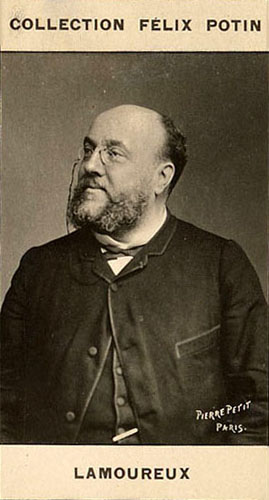
The photo reproduced on the above card was taken by the famous 19th
century French photographer Pierre Petit
(1831-1909). The card itself was published in 1908.
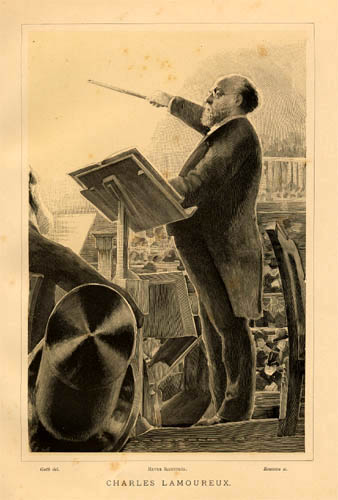
The above engraving, which dates from around 1890, is by Rousseau and was published by the Revue Illustrée.
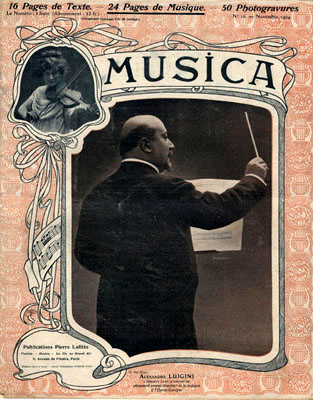
This issue of the monthly journal Musica (no. 26) was published in November 1904.
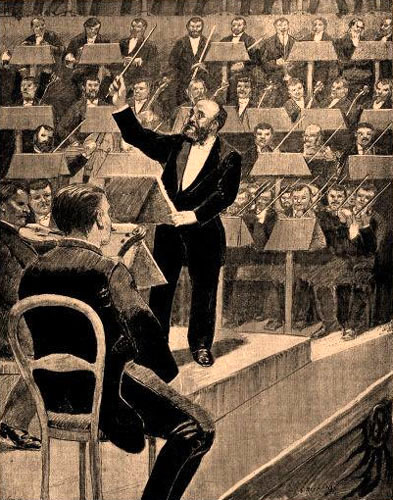
The above picture is courtesy of the Bibliothèque Nationale de France.

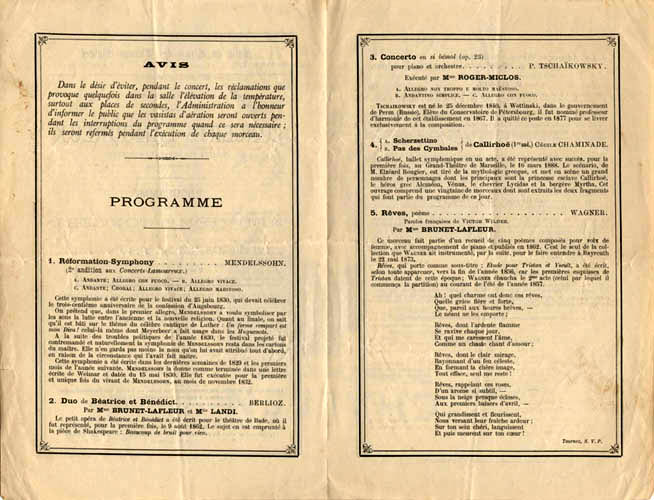
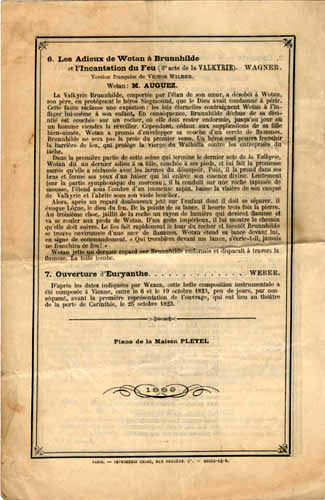
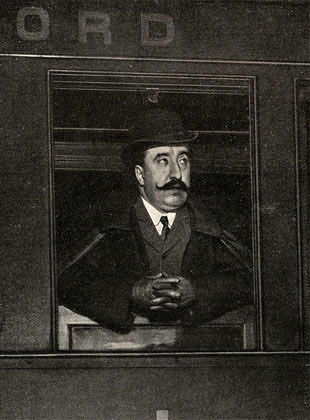
The above photo was published in the journal Musica, no. 26, November 1904, page 415. It shows Camille Chevillard at the Gare du Nord at the moment of departure for a concert tour with the Lamoureux Orchestra (see also below).

‘As travel has an educational function, M. Chevillard has
travelled a great deal:
The musical Association he conducts has followed his example.’
The above cartoon appeared on page 181 of the journal Musica of December 1907, with the title “ Les Concerts sont ouverts ! ” [the concert season is open!].

The above picture is courtesy of the Bibliothèque Nationale de France.

The above photo was published in the journal Musica, no. 26, November 1904, page 415.
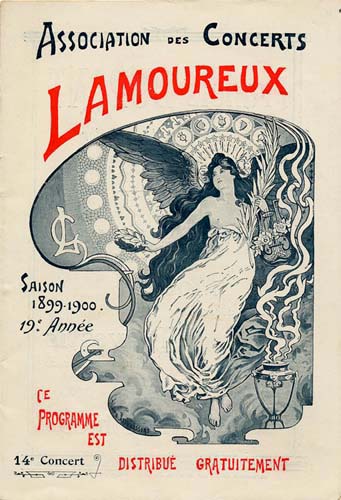

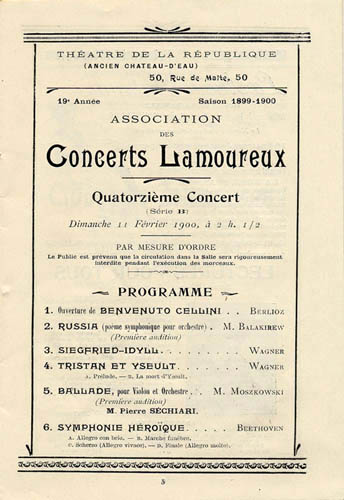
The orchestra’s concerts took place first at the Théâtre du Château d’Eau (from October 1881 till the end of the spring season 1885).
Located in Paris at no. 50 rue de Malte, the theatre was first opened on 11 August 1866 under the name of Théâtre du Prince Impérial. It was then rebuilt on 11 December 1869 and renamed Théâtre du Château d’Eau. Subsequently it changed its name many times: in 1891 it became the Théâtre historique, in 1894 the Théâtre de la République, in 1900 the Opéra Populaire, and once again the Théâtre du Château d’eau in 1901. On 1 September 1903, it was transformed into a music hall under the name of
the Alhambra. In 1925 it was completely destroyed by fire.
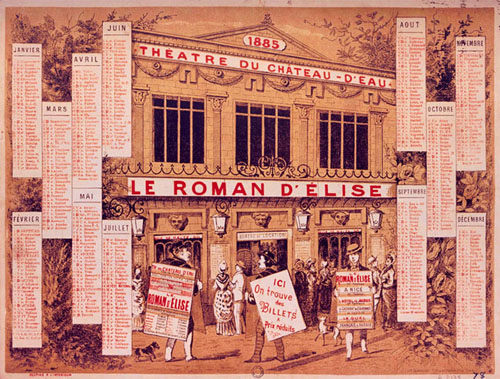
The above picture is reproduced here courtesy of the Médiathèque de Chaumont.

The above picture is reproduced here courtesy of the Bibliothèque nationale de France.
The origins of the building which housed the Eden Theatre go back to 1876 when two French architects, Klein and Dulos, constructed at No. 7 rue Boudreau in Paris, in the 9th arrondissement, a hall in the style of a Hindu pagoda, which was called successively the Eden, then the Grand-Théâtre, and later the Eden-Théâtre. The theatre was inaugurated on 7 January 1883 with the ballet Exelsior. It was demolished in 1895 and replaced the following year by the Square de l’Opéra, now the Square de l’Opéra Louis-Jouvet.
The Lamoureux Orchestra gave their concerts at this venue from the autumn season of 1885 till the end of the spring season 1886.

The above engraving was published in Le Monde Illustré in January 1883.
Apart from the Théâtre du Château d’Eau and the Eden Théâtre, there were other venues at which the orchestra’s concerts took place. Their principal venue, from the autumn season of 1886 to the end of the spring season 1899 (except for a concert at the Cirque d’Hiver on 29 March 1891), was the Cirque des Champs-Élysées, also known as the Cirque d’été. From the autumn season of 1899 they moved temporarily back to the Théâtre du Château d’Eau, renamed at the time Théâtre de la République, because of the refurbishment of the Cirque des Champs-Élysées. In autumn 1900 they moved for a few years to the Nouveau-Théâtre (the future Théâtre de Paris), then in autumn 1906 for one season to the Théâtre Sarah-Berhardt (formerly the Théâtre Lyrique, and the future Théâtre de la Ville), then finally in autumn 1907 to the Salle Gaveau where they remained till 1914. A few concerts also took place at the Palais du Trocadéro.
![]()
The Hector Berlioz Website was created by Monir
Tayeb and Michel Austin on 18 July 1997;
Page Berlioz: Pioneers and
Champions created on 15 March
2012; this page created on 1 March 2013,
enlarged on 1 May 2013.
© Monir Tayeb and Michel Austin. All rights reserved.